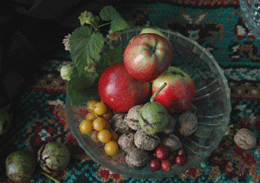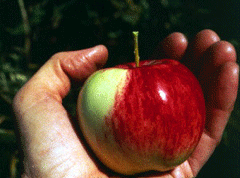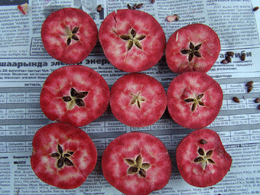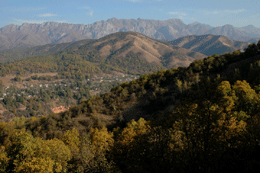Deforesting the Forbidden Fruit
Air Date: Week of May 15, 2009

A bowl of Central Asian fruits and nuts. (Photo: Chris Loades, FFI)
The ancestral species of many fruits and nuts we enjoy in the West are threatened with extinction in Central Asia. A recent report by Fauna & Flora International has found nearly 90 percent of the region's fruit and nut forests have been lost in the past 50 years. The conservation group's Global Trees Campaign coordinator, Georgina Magin, talks with host Jeff Young about what's at stake if the ancestral roots of the fruits we enjoy are lost forever.
Transcript
YOUNG: There’s nothing more American than apple pie.
But, like a lot of Americans, apples have their roots in another country—for the apple the old homeland is present day Kazakhstan. The apple is just one of many important fruits and nuts that descend from ancestral versions still found in the mountain forests of Central Asia. But a recent report by the conservation group Fauna and Flora International shows most of Central Asia's fruit and nut forests are already gone. More than 300 species are threatened with extinction.
Georgina Magin coordinates the group’s Global Trees Campaign. Ms Magin, welcome to Living on Earth.
MAGIN: Thank you very much.
YOUNG: Now I have to confess: this is a part of the world where I am profoundly ignorant, but we’re talking largely about the “stans” here, aren’t we?

(Photo: Chris Loades, FFI)
YOUNG: Now I don’t have a lot of knowledge of this area, but it turns out I probably should be very grateful for some of the very early exports from that area, right?
MAGIN: That’s right. It’s believed that many of the domesticated varieties of fruits and nuts such as apples, apricots, plums, pears originated from these forests. In fact, recent work by the University of Oxford genetic analysis of one of the apple species in the area has shown that it is indeed the origin of almost all domestic apples that we use today.
YOUNG: This is Malus sieversii is that …
MAGIN: Sieversii, yes.
YOUNG: Sieversii, that’s it. That’s the momma apple, huh?
MAGIN: Indeed, indeed. And it’s thought that it was probably transported out of the region long, long ago down the ancient silk road, the trading route between sort of north Asia and China and then going into the Mediterranean and into Europe.

Malus Sieversii, believed to be the progenitor of the apples we eat today, still grows in the Ili Valley of Kazakhstan, but is threatened with extinction.
MAGIN: Yes, indeed. The former capital of Kazakhstan was Almaty and that means in the local language “father of apples.” So clearly apples have been very, very important to the country throughout history.
YOUNG: What is at stake if we lose the origin of the apple? I mean, we have apple trees – we’re not going to lose them. But what’s at risk here?
MAGIN: No, indeed. Well at an international level the wild trees have much wider genetic diversity than we have in the generally fairly genetically narrow domesticated varieties. And this can be very important for resistance to new pests or diseases that might emerge for these crops. And increasingly at the moment in the face of the unknown changes in the global climate that we’re facing and the challenges that those will undoubtedly bring, this huge genetic diversity could be very, very important for the security of these seeds into the future.
YOUNG: So what are the threats, what’s causing us to lose these forests?

Niedzwetzky apples (malus niedzwetzkyana), famous for their red flesh. There are 111 known trees left in the world. (Photo: Kayirkul Shalpykov, Bioresource)
YOUNG: So what is the strategy for trying to protect the forests? I guess it also has to involve improving the lot of life for the people living there.

Local communities throughout Central Asia live off of the fruits of the land. (Photo: Chris Loades, FFI)
YOUNG: You know, the notion of the original apple it has just has taken hold of my mind, I can’t let go of that thought. I can’t help but thinking of some early metaphorical Eve taking a bite of this apple and here we are talking about the great knowledge in it, and its kind of, we’re talking about the fruit of the tree of knowledge, the DNA inside that fruit.
MAGIN: Indeed yes. And there is a belief that this may well have been the type of apple that Eve ate in the Garden of Eden in biblical times. And the fact that it has survived all the way through historical time and is one of the types that we’ve found in our research to be now threatened with extinction and its included in our report.

Kyrgyzstan. The high mountains of Central Asia allowed wild species of fruits and nuts to evolve separately, making the region one of the world’s biological “hotspots.” (Photo: Chris Loades, FFI)
YOUNG: And if we were to lose it – wow, talk about being tossed out of the garden.
MAGIN: [laughing] Absolutely.
YOUNG: Well, best of luck on the project. Georgina Magin is program coordinator for Flora and Fauna Internationals’ global trees campaign. Thanks very much. It’s a fascinating subject.
MAGIN: Thank you very much.
Links
Living on Earth wants to hear from you!
Living on Earth
62 Calef Highway, Suite 212
Lee, NH 03861
Telephone: 617-287-4121
E-mail: comments@loe.org
Newsletter [Click here]
Donate to Living on Earth!
Living on Earth is an independent media program and relies entirely on contributions from listeners and institutions supporting public service. Please donate now to preserve an independent environmental voice.
NewsletterLiving on Earth offers a weekly delivery of the show's rundown to your mailbox. Sign up for our newsletter today!
 Sailors For The Sea: Be the change you want to sea.
Sailors For The Sea: Be the change you want to sea.
 The Grantham Foundation for the Protection of the Environment: Committed to protecting and improving the health of the global environment.
The Grantham Foundation for the Protection of the Environment: Committed to protecting and improving the health of the global environment.
 Contribute to Living on Earth and receive, as our gift to you, an archival print of one of Mark Seth Lender's extraordinary wildlife photographs. Follow the link to see Mark's current collection of photographs.
Contribute to Living on Earth and receive, as our gift to you, an archival print of one of Mark Seth Lender's extraordinary wildlife photographs. Follow the link to see Mark's current collection of photographs.
 Buy a signed copy of Mark Seth Lender's book Smeagull the Seagull & support Living on Earth
Buy a signed copy of Mark Seth Lender's book Smeagull the Seagull & support Living on Earth

